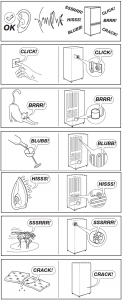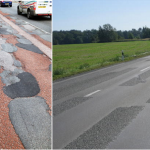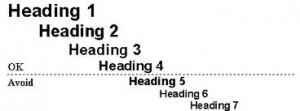How’s Your Freezer Looking (or Sounding) Today?
Posted on March 4, 2014
Filed Under Communication, Technology | Leave a Comment
Gupreet Singh on Technical Writing ToolBox provides an interesting post on adding sounds to technical manuals. That’s right, here’s what a properly functioning home freezer should sound like – and hissing or blubbing sounds, among others, are “pictured”. Pretty creative, was our first impression.
 Yet the mind wanders. I thought (briefly) about how you’d go about depicting the sounds from the equipment in an operating nuclear power plant and realized, from the plants I’ve been in, that the roaring turbine generators, or steam hissing through overhead piping, just about overpowered everything else. On the other hand, though, the control rooms are quiet sanctuaries. But why distract the operators with pictures of normal background sounds they’re quite accustomed to? Documenting directions is one thing, sounds another.
Yet the mind wanders. I thought (briefly) about how you’d go about depicting the sounds from the equipment in an operating nuclear power plant and realized, from the plants I’ve been in, that the roaring turbine generators, or steam hissing through overhead piping, just about overpowered everything else. On the other hand, though, the control rooms are quiet sanctuaries. But why distract the operators with pictures of normal background sounds they’re quite accustomed to? Documenting directions is one thing, sounds another.
Maybe, indeed, illustrated sounds should be left to consumer product manuals, where the new owners are expecting to hear only a hum from their new freezers or refrigerators. And why should that be an unreasonable expectation? – Doug Bedell
Writing Is a Process, Not an Act of Creation
Posted on February 26, 2014
Filed Under Communication, Technology, The Writing Life | Leave a Comment
We’d like to make a distinction here that holds for technical writing as much as for any other kind of writing: Writing is a process, not an act. Writing and editing go together, they are part of the same process. A sentence, a paragraph or a whole page of material doesn’t just get “exhaled” from a word processor in a burst of creativity. The material will likely need to be reworked and tidied up a bit. That’s the writing process , whether in creative or technical writing.
 This important caution occurred as an “Amen,” a hearty acknowledgement, to a video clip by Ugur Akinci, PhD, at the Technical Communication Center, where “tips tutorials and trends” on technical writing and communication are offered. “The division between ‘writing’ and ‘editing’ is artificial,” Dr. Akinci said, “In real life, they are inseparable twins.” That’s inescapably true, and it’s so because, again, writing is a process, not an act of creation.
This important caution occurred as an “Amen,” a hearty acknowledgement, to a video clip by Ugur Akinci, PhD, at the Technical Communication Center, where “tips tutorials and trends” on technical writing and communication are offered. “The division between ‘writing’ and ‘editing’ is artificial,” Dr. Akinci said, “In real life, they are inseparable twins.” That’s inescapably true, and it’s so because, again, writing is a process, not an act of creation.
Good writing requires care, correction and adjustment as one goes along. It may be necessary to explain this to clients from time to time, when they wonder how you spend your time on their behalf. The human creative spirit is an amazing source of information and proficiency, so long as it’s recognized more as a meditation then a thunderbolt. Yes, you can be inspired, but even inspiration will likely require adjustment and polishing. That’s just the way we proceed to be understood clearly and well, whether we’re “creating” or rendering information proficiently. – Doug Bedell
In the Highlands or a Lab, a Writer’s Obligations Persist
Posted on February 10, 2014
Filed Under Communication, Technology, The Writing Life | Leave a Comment
Here are two web commentaries on efficient writing, efficient because it admirably accomplishes its purpose, whether that be to entertain or to instruct. Romance novels are one category, and academic or technical writing another. Technical writing is held to a higher standard of reality, since it describes actual (that is, current) places and/or systems. Romance writing leaves everything to the writer’s conjuring, but a good writer won’t abuse that privileged state.
Academic and technical writing, notes the Precise Edit’s Blog, “can be complicated, tedious and confusing. They can be terribly boring.” And there’s no way to waive such abuses of a reader’s time and attention to duty. Density is density, boring is boring. On the other hand, romance writing, in which the author’s imagination controls the narrative, can be turgid, too.
 Ceci Giltenan is the author of “Highland Solution,” a novel of medieval Scotland published last fall. In her professional life, Ms. Giltenan’s expertise is in drug development “and much of it involves reporting results from human clinical studies. In this kind of writing, one starts at the beginning, tells the full story in chronological order and includes every known detail.”
Ceci Giltenan is the author of “Highland Solution,” a novel of medieval Scotland published last fall. In her professional life, Ms. Giltenan’s expertise is in drug development “and much of it involves reporting results from human clinical studies. In this kind of writing, one starts at the beginning, tells the full story in chronological order and includes every known detail.”
Writing a romance novel, however, is more like creating and solving, or leading the reader to solve, an imagined puzzle. “I provided the pieces and left the reader to put them together.” Leaving it to the reader to put a piece of technical writing together, though, could lead to real-time peril. The two are not equivalent kinds of writing.
Yet both romance and technical writing need to engage their readers, either by stirring their imaginations or leading them efficiently through a process. And authors can write badly in both disciplines. Considerations of innate talent aside, why might they do that? Possibly technical writers might think their writing “is supposed to be dull and confusing, or perhaps they think it sounds more professional,” suggests the Precise Edit’s writer. Or “maybe they have read a lot of poor writing, so when they review their writing, it sounds ‘right.'” Oh dear.
In the case of a romance writer under full steam, a tale has to hang well together. “I still create an extensive dossier capturing details on each character’s life and use it to help determine what they might do in any situation,” notes Ms.Giltenan.
“However,” she adds, “unlike a clinical study report, the most compelling story is not necessarily told chronologically and I am not required to spoon feed the reader every detail. Deciding what parts of the puzzle to reveal has become almost as much fun as being all-knowing.”
“Fun” isn’t the technical writer’s preserve. But being as meticulous as knowing what life in medieval Scotland was like is obligatory there, too. Effective writers can’t escape their obligations in whichever realm – real world or fanciful – they may be active. – Doug Bedell
College Students Aim to Provide Cell Phone Charging for Gambians
Posted on February 3, 2014
Filed Under Communication, Education, Technology | Leave a Comment
Credit Elizabethtown College, in Elizabethtown, Pa., not far from Encore’s home office, with being on the cutting edge of technological utility on behalf of others. “Utility,” in this case, means using “crowdfunding” to raise funds to help people in Gambia, Africa, “establish a business that will manufacture and sell cell phone chargers in The Gambia.”
 A group of Elizabethtown students and faculty is aiming to raise $6,000 to complete the design and assembly of photovoltaic mobile phone chargers for long-term field-testing in Gambia. What’s the big deal about that? Well, explains the E-town group, “Most rural Gambians have little or unreliable access to electricity in their country. Yet, the cell phone is readily available and an essential tool for routine daily communication and commerce. The cell phone offers a true lifeline. However, recharging is a major challenge.”
A group of Elizabethtown students and faculty is aiming to raise $6,000 to complete the design and assembly of photovoltaic mobile phone chargers for long-term field-testing in Gambia. What’s the big deal about that? Well, explains the E-town group, “Most rural Gambians have little or unreliable access to electricity in their country. Yet, the cell phone is readily available and an essential tool for routine daily communication and commerce. The cell phone offers a true lifeline. However, recharging is a major challenge.”
So students and faculty at this Pennsylvania college are developing and making available to Gambians a sun-powered cell phone charger. Moreover, the charger is only the first of what they see as products to issue from an “ongoing social business incubator, focused on moving away from charity to develop the technical capacity and entrepreneurial spirit needed for solutions to other problems to develop locally.”
What a terrific way of learning and serving at the same time! And what a credit to creative American outreach in general! The E-town group is working with a U.S. Peace Corps program in Gambia.
For students to size up a development problem and then provide the means of alleviating it in a quasi-commercial manner is a great learning, relational and philanthropic experience. May there be many upbeat cell phone messages exchanged in the rural sectors of Gambia! – Doug Bedell
Technical Directives are ‘Content,’ Too
Posted on November 23, 2013
Filed Under Communication, Technology, The Writing Life | Leave a Comment
It was inevitable, and probably not worth fussing over, but technical writing is now referred to, along with all the world’s other information, creative or otherwise, not simply as “information,” “instructions” or “directions,” but as content. Yes, the Big C now encompasses technical writing as, generically, it always did.
 In reflecting on the 50th anniversary of President Kennedy’s assassination, TechWhirl notes how the media/information world has evolved since then. “One thing that has surely changed” the site notes, “is how we find about the details of these national and global tragedies. In 1963, everyone waited for news from venerated news men such as Walter Cronkite, or tuned in their radios as a relatively few reporters bore responsibility for getting the facts out across the newswires. In 2013, we wait for nothing … we get pictures as they happen from the everyday citizens in the street, supplemented by non-stop coverage in the 24/7 cable news cycle. In 1963, the vast majority of humanity were relegated to passive consumers of news. Today, the vast majority can and do actively participate in creating and distributing—in sharing—news and other content.
In reflecting on the 50th anniversary of President Kennedy’s assassination, TechWhirl notes how the media/information world has evolved since then. “One thing that has surely changed” the site notes, “is how we find about the details of these national and global tragedies. In 1963, everyone waited for news from venerated news men such as Walter Cronkite, or tuned in their radios as a relatively few reporters bore responsibility for getting the facts out across the newswires. In 2013, we wait for nothing … we get pictures as they happen from the everyday citizens in the street, supplemented by non-stop coverage in the 24/7 cable news cycle. In 1963, the vast majority of humanity were relegated to passive consumers of news. Today, the vast majority can and do actively participate in creating and distributing—in sharing—news and other content.
“We, as content creators and deliverers, with some special types of expertise, still have much to learn about the processes: what constitutes news and facts, or even the “right” content?….”
In referring to themselves as “content creators,” TechWhirl’s editors, are of course, referring to their posts, not to technical writing (procedures and the like) as such. But it’s a ready extension to include our entire nuts-and-bolts craft as well. Technical writers (like web editors) need to know about the details of their offerings and about using pictures or diagrams to get make instructions as inclusively complete and helpful for their own “everyday citizens (users)” as readily as possible.
So, not cutting it too fine, good, well-organized writing, in whatever context and for whatever purpose, is, and has always been, content, which, itself, has surely been a buzzword as 2013 begins to turn. Hail to all content creators who do their work carefully and well! – Doug Bedell
Notable Note-taking – Keep Your Notes for Reference
Posted on November 7, 2013
Filed Under Communication, Technology | Leave a Comment
You don’t have knowledge of any depth unless you keep notes – that is, you’re not likely to retain knowledge accurately without referring to the notes you take on it. And least most people aren’t that retentive.
 T.R. Grill, of the Society for Technical Communication at Lawrence Livermore National Laboratory, elaborates on the importance of note-keeping as much as note-taking. He leads off by citing a time-enshrined example of invaluable jotting, noting an observation by Eric Greene, a University of Montana biology professor, that “Henry David Thoreau’s field notes on the flowering times of 500 plants near Concord, MA (recorded in 1851-58), are still used today for comparison with current climate-change data.” Talk about (note-assisted) continuity of observation!
T.R. Grill, of the Society for Technical Communication at Lawrence Livermore National Laboratory, elaborates on the importance of note-keeping as much as note-taking. He leads off by citing a time-enshrined example of invaluable jotting, noting an observation by Eric Greene, a University of Montana biology professor, that “Henry David Thoreau’s field notes on the flowering times of 500 plants near Concord, MA (recorded in 1851-58), are still used today for comparison with current climate-change data.” Talk about (note-assisted) continuity of observation!
Greene would like to see science students “widen the scope of their note-taking to extend beyond just observations or numerical data to also include memory aids, organizational aids and commentary.” In other words, jot down what you find, what you do and how it works out.” Sometimes, we’d add, with an iPhone or iPad at hand, that may be extra enticing. Possibly you can take photos instead of making sketches. (And valuable activity like note-taking can help justify what you paid for the devices.)
Even without Apple’s company, keeping a notebook (ruled or unruled) is mandatory if you’re a technical person. That, after all, is the way it’s always been. You can, as Greene notes, include claims, guesses and questions in your notes so that you get a complete emerging picture of what you’re developing or analyzing.
Encore’s Dennis Owen recalls the importance of ready access to personal notes from his laboratory days at General Electric, his first job after college, “when I was a note-taking fool afraid I’d miss something that was important:
“When my boss asked, ‘What happened when the temperature got to so and so?’ the answer was in my lab notebook.”
For the sentimental among us, notes can have the same recall value as treasured photographs. But whether they enshrine sentiment or not, notes definitely have lasting value. You wouldn’t want to rely on your memory alone to replace them, not ever.
When Grill gets to the point of discussing the two-column “Cornell format” for notes, the URL he supplies unfortunately wasn’t working for us, but maybe it is now. Even so, you can also involve Google in your research and note-taking on note-taking. Whatever works for you when it comes to taking and retaining notes, keep doing it. – Doug Bedell
Analogies for Good Content – It’s Smooth, for One
Posted on October 28, 2013
Filed Under Communication, Technology, The Writing Life | 2 Comments
Okay, need an excuse for being an orderly writer? You shouldn’t, but if you do, look at it from the viewpoint of the content you’re working with. Oh really?
 Well, that’s what a writer named Vinish Garg suggests you do in a post on the Enjoy Technical Writing (ETW) blog. Content, he feels, doesn’t like to be jostled around, or crammed into any place it seems it might fit. It seems to have bearings, real emotional needs, of its own. Garg uses analogies with a parking lot, a poorly patched road and a merge lane on a highway. The one we like best, that seems to fit best, is the poorly patched road.
Well, that’s what a writer named Vinish Garg suggests you do in a post on the Enjoy Technical Writing (ETW) blog. Content, he feels, doesn’t like to be jostled around, or crammed into any place it seems it might fit. It seems to have bearings, real emotional needs, of its own. Garg uses analogies with a parking lot, a poorly patched road and a merge lane on a highway. The one we like best, that seems to fit best, is the poorly patched road.
Content that doesn’t fit well, that doesn’t really belong in the place a careless writer put it, is like adding another sloppy patch to a poorly patched road. It’s not smooth, but bumpy. It causes the reader to wonder, “Does this make sense? Is it really correct? Does this really belong here?” And you don’t want to slow too much a driver whose main interest is breezing his way to understanding, or at least steering smoothly through a difficult patch. Readers, obviously, don’t like detours, roadblocks, or too many bumpy spots.
That’s not to agree that content has a mind, or intent, of its own, as Vinish Garg evidently feels, only that the reader does. He or she wants content that makes sense without too much steering. Good writing isn’t a game of bumper cars. – Doug Bedell
Pinterest for Tech Writers? You Bet!
Posted on October 1, 2013
Filed Under Business, Communication, Technology | Leave a Comment
It might seem counterintuitive to link Pinterest – the pinboard Web app you tend to associate with garden parties and interior decorating – with technical writing. But that’s wrong. Witness the marvelous job Ugur Akinci has done on Pinterest with his technical writing pinboard. In addition to being a Fortune 100 technical writer, Ugur is an online course designer, a lover of Bossa Nova, running, singing in harmony, positive thinking and meditation. A real renaissance man in a Web setting!
 Ugur has a couple of dozen other pinboards besides the one on technical writing. Pinterest ought to be using him as a demonstration of the range of its engaging technology. Everything from Films of Cary Grant tp Technical Communication. And Ugur keeps on servicing them all; he seems particularly in love with Hawaii.
Ugur has a couple of dozen other pinboards besides the one on technical writing. Pinterest ought to be using him as a demonstration of the range of its engaging technology. Everything from Films of Cary Grant tp Technical Communication. And Ugur keeps on servicing them all; he seems particularly in love with Hawaii.
We wonder how today’s Web men and women have time for all the surfing, designing and posting they do, and still maintain their sponsoring discipline, in this case technical writing. It’s an expressive medium, to be sure, but there’s usually not a copydesk rimmed with green-eyeshaded proofreader/headline writers to help with it. We note that Ugur is a PhD, which doubtless has something to do with his capacity for productive creativity. A lot of it has to do with thinking through your aims and concepts beforehand.
Anyhow, Pinterest is a delightful means of portraying your interests on the Web, and thereby doing yourself – whether you’re a technical writer, sprinter or a homemaker – a celebratory service. – Doug Bedell
Persistence Rewarded M.J. Hurley
Posted on September 12, 2013
Filed Under Business, Communication, Technology, The Writing Life | Leave a Comment
Dennis Owen and I admire greatly M.J. Hurley, a technical writer whose accomplishments we read about in a Washington Post column by Thomas Heath. M.J. has built a technical writing business that earns her $400,000 annually. She did it through persistence and inspired toil, inherited from her mother, who was killed when she walked into a robbery at a 7-Eleven store in North Carolina 38 years ago.
 After teaching and working on her PhD, M.J. decided to go into technical writing and landed her first contract at PPD, a pharmaceutical company in Wilmington, N.C. She landed that work out of sheer tenacity. “I called anyone at PPD who would listen to me,” M.J. recalled. She finally got a contract that “included teaching all new PPD employees to write internal documents.” One of the women at PPD took her aside and told her she wasn’t charging enough, so she upped her rate, in light of the value her technical writing services were adding to the company’s functioning.
After teaching and working on her PhD, M.J. decided to go into technical writing and landed her first contract at PPD, a pharmaceutical company in Wilmington, N.C. She landed that work out of sheer tenacity. “I called anyone at PPD who would listen to me,” M.J. recalled. She finally got a contract that “included teaching all new PPD employees to write internal documents.” One of the women at PPD took her aside and told her she wasn’t charging enough, so she upped her rate, in light of the value her technical writing services were adding to the company’s functioning.
“I don’t teach grammar,” M.J. says, “I teach critical thinking. You always have to think about the point you are making. Whether you are writing a user manual, an engineering report or telling your boss what you accomplished on a trip, you have to remember what you are trying to accomplish. You are writing for the customer, not for the person next to you in the pod.”
That’s the aim of any good writing – its impact in the context of its intended use. Technical writers, like any other writers, need appropriately high horizons. M.J. is in demand by managers “who find themselves spending too much time rewriting the reports handed in by their staffers.”
That registers with Dennis. “I basically got my start as a technical writer,” he recalls, “when one of the managers I worked for in Idaho noticed I could write and started giving me reports from other engineers to fix so he didn’t have to. That seems like eons ago.”
“My favorite all-time edit (I’ll never forget it),” Dennis adds, “was when an engineer was writing about a calculation and instead of writing ‘multiply the value by six,’ he wrote ‘the value is augmented by a multiplicative factor of six’…I love that.”
M.J.’s work and the recognition it’s been receiving, Dennis notes, “illustrates how valuable good, concise writing is to a company.” It surely does. – Doug Bedell
(Photo of M.J. Hurley)
Subheads for Clarity, If not Beauty
Posted on August 30, 2013
Filed Under Communication, Technology, The Writing Life | Leave a Comment
Technical writing needs to be orderly, but to insure that it’s read and understood by busy people, it definitely shouldn’t be dense. Aside from writing reasonably short, orderly sentences, adding subheads when the focus changes a bit is a mechanical, but very helpful, way of keeping a reader with you. Subheads are perhaps a tech writer’s most valuable organizational tool.
 Tom Johnson, on his excellent “I’d Rather Be Writing” technical writing blog, deals with the virtues of subheads at some depth. Tom took a poll on why “users can’t find answers in help material.” And he found that “help is either too long so users can’t find the answer, or help is too short so users can’t find the answer.” So what’s needed is a mechanism to facilitate organizing and scanning a page. (Oh, there’s that “f” word again.) Subheads are the answer both to orderly writing and orderly page layout.
Tom Johnson, on his excellent “I’d Rather Be Writing” technical writing blog, deals with the virtues of subheads at some depth. Tom took a poll on why “users can’t find answers in help material.” And he found that “help is either too long so users can’t find the answer, or help is too short so users can’t find the answer.” So what’s needed is a mechanism to facilitate organizing and scanning a page. (Oh, there’s that “f” word again.) Subheads are the answer both to orderly writing and orderly page layout.
Use subheads, first, to organize material that belongs together and then to draw your reader’s eyes to your handiwork. You’ve made his or her day when it’s easy to follow what you’re presenting. Subheads along with reasonably clear writing are the answer. They’re both attractive typographically and highly utilitarian. (Below a subhead, or instead of one, a “bullet” dot to set off key sentences or paragraphs can also be helpful.)
A maximum of four indented subheads on a page, as illustrated here, may actually be too many, unless your material is so complex that it requires them. Definitely avoid run-on subheads, as much as run-on writing. The idea is to be organized, not typographically lush. Typographical techniques aren’t a substitute for clear, well-organized writing, just helpmates in negotiating your terrain. The eye can be distracted by too many of them.
“Almost any Wikipedia page provides a great example of subheadings in action,” Tom notes. “There we have many paragraphs of content broken up by subheadings, with a built-in navigation embedded at the top. It’s a model that seems to work well on the web.” Subheads work well on paper, too, if they’re not overdone. Keep them always in mind as your technical writing unfolds. – Doug Bedell
« go back — keep looking »Recently
- Presentations With Forethought
- Technical Writing’s Lineage – Surely It’s Deeper than Digital
- At the Holidays, Twitting Amazon
- Successful Cookie Baking – From Mom, an Acknowledged Expert
- Slides for a Tech Writer’s Craft
- Digital or Not, Be Clear
- Being Watchful About Digital Designs…
- When Proposals Don’t Click, Keep Making Them Anyway
- Like a Good Gardener, Help an Enterprise Keep Itself Current
- We’re Leaders All, And Need to Think That Way
Categories
Archives
- January 2017
- December 2016
- November 2016
- October 2016
- September 2016
- August 2016
- July 2016
- June 2016
- May 2016
- April 2016
- March 2016
- February 2016
- January 2016
- December 2015
- November 2015
- October 2015
- September 2015
- August 2015
- July 2015
- June 2015
- May 2015
- April 2015
- March 2015
- February 2015
- January 2015
- December 2014
- November 2014
- October 2014
- March 2014
- February 2014
- January 2014
- December 2013
- November 2013
- October 2013
- September 2013
- August 2013
- July 2013
- June 2013
- May 2013
- April 2013
- March 2013
- February 2013
- January 2013
- December 2012
- November 2012
- October 2012
- September 2012
- August 2012
- July 2012
- June 2012
- May 2012
- April 2012
- March 2012
- February 2012
- January 2012
- December 2011
- November 2011
- October 2011
- September 2011
- August 2011
- July 2011
- June 2011
- May 2011
- April 2011
- March 2011
- February 2011
- January 2011
- December 2010
- November 2010
- October 2010
- September 2010
- August 2010
- July 2010
- June 2010
- May 2010
- April 2010
- March 2010
- February 2010
- January 2010